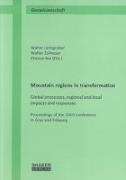Mountain regions in transformation
BücherAngebote / Angebote:
Mountains cover about a quarter of the world's landmass and are inhabited by about one tenth of the global population. Although there is no accepted general definition, they are distinctive features on all continents, and they have attracted a lot of attention through the ages. Humans were often forced to travel into and across mountains when settling virgin lands or engaging in trade, war or conquest, and the inhabitants of the lowlands were probably aware of the significance of mountains for their livelihood. It was the Geneva scientist Horace Bénédict de Saussure (1740-1799) whose measurements and observations on the Mont Blanc (1787), situated on the French- Italian border, prompted the interest of science. This was followed by the 'discovery' of mountains by tourists. The first ascension of the Jungfrau in the Bernese Oberland took place in 1811, and the expedition by Edward Whymper on the Matterhorn (on the Swiss-Italian border) in 1865 sparked off mountain tourism on a larger scale.
Mountains are very often considered remote and economically unattractive regions that require outside help to survive. It is true that natural hazards and difficult living conditions cause an extra cost to the economy and confront the inhabitants with particular hardships, but at the same time they are economically important as tourist destinations and as sources of hydroenergy.
The 20th and early 21st centuries have witnessed a spectacular rush towards mountains, which is posing a substantial the challenge. Mountain sports like skiing and rock climbing and adventure activities such as river rafting, hang gliding, heliskiing etc. are attracting rising numbers of tourists. The price to pay is the everincreasing stress on the mountain environment. Since the late 19th century mountain regions have also been used for the production of hydroelectricity, with negative consequences on the water system. Roads, railways and cable cars have improved their accessibility.
This in turn has led to dramatic changes in both mountain society and economy. Tourism and hydroelectricity have created new and better paid jobs, while mountain farming has become less and less profitable. Farmers have often managed to obtain part-time jobs as skiing teachers and mountain guides, but only in tourism regions. Elsewhere many young people have migrated down the valleys or directly into the lowlands, to large cities, thereby weakening their villages demographically, economically, and socially.
The present book illustrates a number of processes occurring in mountain regions across the globe. While each case study is unique, they all represent similar tendencies in the evolution of mountain regions. Grouped around four broad themes (mountain environment, social aspects of marginalization, economic development, and policies and strategies) the individual chapters illustrate the highly diverse nature of mountain regions concerning ecosystem and human occupancy.
Noch nicht erschienen
